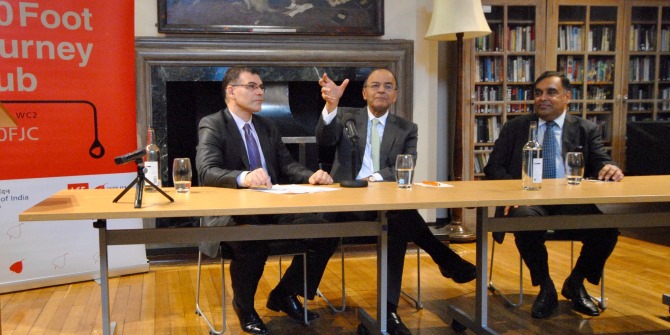 The Bangladeshi government’s decision to build a coal power plant close to the Sundarbans, a UNESCO World Heritage mangrove forest celebrated for its biodiversity, has resulted in extensive public protest. In this article, Tasmiah Rahman discusses why the government is pressing ahead with the project and calls for leaders to take into account civil society objections over the likely environmental impact.
The Bangladeshi government’s decision to build a coal power plant close to the Sundarbans, a UNESCO World Heritage mangrove forest celebrated for its biodiversity, has resulted in extensive public protest. In this article, Tasmiah Rahman discusses why the government is pressing ahead with the project and calls for leaders to take into account civil society objections over the likely environmental impact.
Citizens of Bangladesh have been protesting against the most controversial decision of government in recent times: the Rampal coal power plant. The reason for the controversy is simple- it is only 14 kilometers from the Sundarbans, a unique expanse of mangrove forest and is listed as a UNESCO World Heritage site. It is rich in biodiversity that cannot be monetized. Apart from being the home of endangered Royal Bengal Tiger, Sundarbans is the home of other rare species like Masked Finfoot, Estaurine Crocodile, Olive Ridley Sea Turtles, Gangetic dolphin, King Crabs and thousands of other living beings. The government, including Prime Minister Sheikh Hasina herself, has issued assurances that this power plant will take all environmental issues into account. She has emphasised that this project is necessary to meet the country’s growing electricity demands as it will produce 1,320 megawatts of electricity. In addition to the government’s plant there will be another privately owned power plant. The head of the state also suggested that the objections that have been raised are baseless propaganda generated by the opposition party. However, the civil society disagrees.

Reports about the protests have been flooding the newspapers and social media since the decision was made public. The latest protest drew much intolerance from both police and the student body of the ruling party, Awami League. Earlier in the month, the National Committee to Protect Oil, Gas, Mineral Resources, Power and Ports declared mass protests to follow from November if the environmentally degrading project is not dismissed. In a recent press conference the committee has announced their own study findings on the power plant and urged the government not to go through with the project. The country’s civil society: professors, students, environment lawyers, various environmental groups, media, among others have voiced their concern over the project. Bangladeshi citizens abroad have also protested against the plant.
It is clear that citizens are not convinced by the government’s assurance to protect the Sundarbans. Global climate change threatens the unique biodiversity of the forest, which is already at risk due to unlawful logging and deer poaching. . Furthermore, one-off incidents such as an oil spill in 2014 have been highlighted in international media as further endangering the fragile ecosystem. Protesters are certain that the new coal-based power plant will add to the damage being done.
Professor Anu Mohammad has been leading the campaign against this project and his concern is government’s reluctance in taking proper measures in the preparation phase. A Dhaka University Professor Dr Badrul Imam has suggested that the plant be moved another 10 km from Sundarbans so that the damages are minimised. The Environment Impact Assessment (EIA) conducted by the government has been termed ‘grossly faulty’ by the environmental attorney and chief executive of Bangladesh Environmental Lawyers’ Association (BELA), and winner of Ramon Magsassy award, Syed Rezwana Hasan. UNESCO has also voiced concern over the power plant that government should take into consideration.
Why does the government want to go ahead with the Rampal power plant, anyway?
1) Pursuit of ‘middle income country’ status
Bangladesh is on its way to becoming a middle income country by 2021, according to the Ministry of Foreign Affairs. The World Bank also validates this claim and highlights ‘job creation’ as one of the top development priorities for Bangladesh because the country needs to create accessible and better opportunities for 2.1 million youths that will enter the job market every year in the near future. Creating jobs requires more businesses, supported with proper infrastructure and affordable power supply. The additional power supply will also help to curb severe power shortages that the country has faced over the last decade.
On the flip side, global trends show a decline in the usage of coal in electricity generation whereby even countries like China are moving away from coal to more renewable sources of power generation. This raises the question of whether Bangladesh should be investing in coal fired power plants to meet its goals
2) Bangladesh’s success on MDGs and private sector support for achieving SDGs
Bangladesh is considered a success case when it comes to Millennium Development Goals (MDGs). The country has performed much better in poverty reduction and human development indexes compared to its neighbours. The government’s effort to continue this trend in terms of economic growth and massive infrastructure development initiatives are praiseworthy. The country now gears up to take on the Sustainable Development Goals (SDGs) seriously, aiming for substantial collaboration from the private sector that requires an enabling environment for both domestic and foreign direct investments. …
By ensuring more electricity generation, the country is focusing on creating an enabling environment for businesses that will need such infrastructure support from the government. But perhaps the government can build the power plant a bit further away as mentioned above or look into alternative solutions, which can minimise the negative effects on Sundarbans.
3) Relations with India
The bilateral relationship between India and Bangladesh has never been better. The partner organisation in Rampal is India’s largest power thermal agency National Thermal Power Corp (NTPC). The decision to go ahead with such an initiative was cemented when Prime Minister of India, Narendra Modi endorsed the power plant project. Therefore, any move by the government to revisit the deal risks undermining the current streak of positive bilateral relations.
However, criticisms have come in from Indian environmentalist claiming that such a power plant would not be allowed in the Indian side of the Sundarbans as it would have devastating effects on the environment. Why, then, should it be permitted in Bangladesh?
What comes next?
In the past, protests have worked to halt the construction of coal based power plants in Bangladesh. A nonviolent protest against an open pit coal mine in Phulbaria was successful as activities were stopped in light of livelihood and displacement issues. For the Sundarbans, protests will be ongoing as long as the government does not address the protests of the citizens. The government should take civil society’s concerns into consideration and come up with solutions that will address Bangladesh’s energy needs without further threatening its unique mangrove forest. It is understood that the government is focusing on economic growth for taking the country forward. However, such growth should not come at a cost of degrading the environment.
It will not possible to ‘build’ another Sundarban!
This article gives the views of the author, and not the position of the South Asia @ LSE blog, nor of the London School of Economics. Please read our comments policy before posting.
About the Author
 Tasmiah Rahman recently graduated from LSE with an MSc in Social Policy and Development. She is currently working as a Senior Manager, Monitoring Results Measurement and Communications in an international NGO in Bangladesh.
Tasmiah Rahman recently graduated from LSE with an MSc in Social Policy and Development. She is currently working as a Senior Manager, Monitoring Results Measurement and Communications in an international NGO in Bangladesh.
Tasmiah is a regular contributor to South Asia @ LSE. Read her previous posts here.







